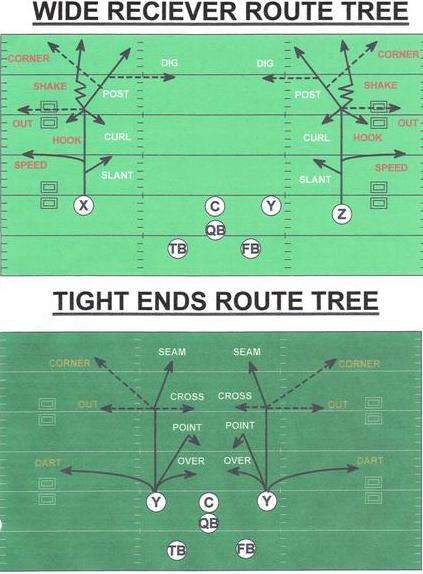|
Defensive Back Technique, Terminology, & Route ConceptsDefensive Back Terminology
Terms: Definition: Bail- Technique used by DB from press alignment, to bail out before snap to area of responsibility Box- Technique used to take on a block. Your nose to outside eye of blocker keeping your outside arm and leg free Bump- Passing of coverage responsibilities of a receiver from one defender to another. Buzz- Curl/Flat drop in 3 deep coverages China- A combination route with 2 WR’s where #1 runs some sort of hitch or stop route 5 yards or under and #2 runs a deep corner. Cloud- Run support call where the corner has the flat area and primary run support Combo- Call made between two defenders in man coverage that tell them to play in and out vs. two receivers aligned close together. Crack- A down block by a WR(Wide Receiver) on an outside defender. Cushion- Vertical distance between receiver and defender I/S Release- Inside release O/S Release- Outside release Lock- Coverage assignment on an offensive receiver given prior to snap. No in and out. Loose- Term to tell coverage defenders to deepen alignment expecting pass Man Turn- DB opens and turns towards his man when covering a WR. Mug- Technique used by a corner in press alignment. Corner will jump at receiver on snap to try to catch him of guard. Nasty- Call made by the corner to indicate a tight split by #1 Re-Route- Disrupt receiver before dropping to a Zone Slant Technique- Corner technique, aligning and play inside slant route in Cov. 2 vs. 3x1 (by game plan) Spill- Technique Used to take on a block using outside shoulder to force the football to bounce outside. Splatter- Technique used to take on a block by cutting the inside leg to force the football to bounce outside. Zone It- Call between 2 DB’s playing an up field in and out coverage on 2 receivers Zone Turn- DB opens and turns towards the QB when covering a WR. *These Terms will be used throughout the site, so to eliminate confusion, it is important to be familiar with them* RoutesDefensive Backs must be prepared for the following route combination's. Become familiar with them so it becomes second nature to identify. These routes are used by any basic offensive scheme, running basic offensive football plays.
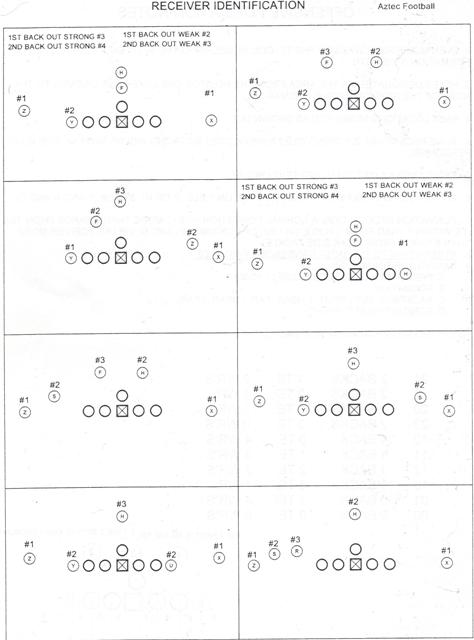
Coverage Techniques
Below you'll find defensive back drills and tips for the most basic defensive coverages. Whether you are learning how to play football, or already know, understanding how to play within these coverages will put a defensive back in a good position to make plays. *Visualization is the first step to success. As you study these tips, be sure to visualize how YOU will make plays from the information provided* Cover 1
Cover 1 for a defensive back is a man to man coverage. This means that corners and safeties will be locked on a receiver. No passing of routes, and no squatting in zones, man coverage is staying with your man at all times. As you go over the information below, be sure to practice the defensive back drills provided for this coverage. Man Coverage Technique Tips: Alignment Corners: In man coverage a corners alignment is usually about 8 yards deep and 1 yard inside. This of course is when a corner is playing off of the receiver, as opposed to playing press. If the receiver has a Nasty split, then the corner would then change his alignment to head up. Free Safety & Strong Safety: Safeties for the most part cover slots and T.E.’s. On a slot, a safety should play head up since a slots split is so tight to the core. A safeties depth on a slot depends on the alignment of the corner. If the corner is playing off, a safety should play press technique in order to avoid pick routes by receivers. If a corner in playing press, then the safety should play off at about 7 yards. On a T.E., a safety should play 8 yards deep and head up. 3 Step Drop Corners: Watch QB for 3 step drop. At the snap of the ball, a corner should back pedal slowly, keying the QB for his first three steps. Corners do this so that they might get a jump on any balls that may be thrown quickly. Quick routes consist of quick slants, speed outs, stop routes or screens. The faster a defensive back recognizes quick routes, the faster he is able to break on the ball and make a play. Though if the receiver is in a Nasty split there is no reading of the QB, and the corner keeps his eyes on his man. Free Safety & Strong Safety: Safeties should never watch the QB for 3 step drops unless they happen to be facing a receiver with a wide split. Keys Corners & Safeties: Keep your eyes on your man. After reading a 3 step drop, a DB’s eyes should quickly go back to the receiver. In man coverage it is very important that a DB keeps his eyes solely on his man. Looking back at the quarterback in many cases can cause a DB to lose sight of his man, which in turn results in a completed pass. After reading the QB a DB’s eyes should go straight back to his man, and stay there. Press Technique Corners: Many coaches like to play the press technique in different Cover 1 situations. To play the press technique a corner should have his feet shoulder width apart, while being on the balls of his feet. His alignment should be a shade inside, fighting hard not to lose his inside leverage. As the receiver releases, it is important for a defensive back to stay square. If the receiver releases left or right, the DB must then shuffle left or right. Crossing over will put a DB in a situation to get beat. Opening up as a receiver releases will put a DB in a situation to get beat. Staying square, keeping inside leverage, and shuffling is the proper technique to use when in press alignment. Free Safety & Strong Safety: The stance of a safety in press technique is the same as a corner. Though since a safety is usually in a head up alignment, the inch back technique is good to use when pressing slot receivers. Corners & Safeties: When utilizing the jam (striking the receiver as he releases) a DB should NEVER lunge. DB’s use quick strikes of the hands without taking a step forward. If the receiver releases inside, the DB must deliver a hard strike with his inside hand, fighting hard to maintain his inside leverage. If the receiver gives an outside release, the DB must then strike with the outside hand, but stay square so that the receiver may not cut back across his face. Playing the Fade Corners and Safeties: From the press technique, as a DB recognizes a fade route he should work hard to cut off the receiver’s route by Man-Turning, and initially not looking back for the ball. Once the DB has the receivers route cut off and is in good position, he can then turn and look for the ball. If a DB fails to cut off the route, he should not look back for the ball but instead play the hands and eyes of the receiver. *When playing the fade from a press technique, the receiver may try and take a wide angle so to put the DB in a trail position. To prevent this, instead of chasing a receiver as he widens his route, a DB should take a diagonal path, and get on top of the receiver* When playing off of the receiver, the most important point for a DB to remember is his Cushion. A good cushion is about 4 yards. If a receiver breaks down the cushion between him and the DB, he’ll more than likely run right by him. Keeping a good cushion from the receiver is important because it gives DB’s the time necessary to turn and run with the receivers. Remember, receivers are running straight ahead while DB’s run backwards. A DB must give himself a chance to make plays by keeping the proper distance between him and the receiver. Cover 2Cover 2 is a two deep zone coverage. Zone coverage is different from man because it requires all DB’s to defend a specific zone of the field. This means DB’s can pass off receivers to other defenders in different zones. DB’s are not running with receivers who leave their zone, and must also key the QB. As you go over the information below, be sure to practice the defensive back drills provided for this coverage. Cover 2 Technique Tips: Alignment Corners: A corners alignment in Cover 2 is 5 yards deep with his inside foot to the outside foot of the WR. Unlike man coverage, in cover 2 corners want to force WR’s to go inside instead of outside. Free Safety & Strong Safety: A safeties initial alignment in cover 2 is 10 yards deep, and 2 yards outside the end-man on the line of scrimmage. If there is a slot receiver, his alignment will be 12 yards deep and 2 yards inside the slot. As the QB goes through his cadence, the safety should slowly begin to move to his landmark, which is between the hash and numbers. At the snap of the ball the safety should be around 15 yards deep between the hash and the numbers. Keys Corners & Safeties: In this coverage a DB’s primary key is the QB. Keying the QB to the #1WR. Responsibilities Corners: In cover 2 the corner is a curl to flat player. He takes any shallow routes to his zone, and squats underneath deep routes with a landmark of 10-12 yards deep, at the bottom of the numbers. On run plays the corner is primary force (The run is his first responsibility, and pass is second), reacting quickly when he sees run. When the WR releases for pass, the corner must jam and re-route him. If the WR releases outside for a pass, the corner must stay square and force him as flat, and as wide as possible. With vision on the QB the corner must carry the WR to shrink the void between him and the safety. If the WR releases inside, the corner must force him inside and then hinge at a 45 degree angle. The corner must work for depth and width to help on the 7 route. If the WR continues to release inside the corner must not chase since the WR has already rerouted himself. A corner must only jump flat routes when the QB’s intentions take him there. *A corner must know how many threats he has. If there’s 1, 2, or 3 receivers. This will help him anticipate routes. With one immediate threat, you can be more aggressive or get up and jam #1. With 2 threats the corner has to be aware of what combo routes he may get.* The following are combo routes with different WR releases for corners: 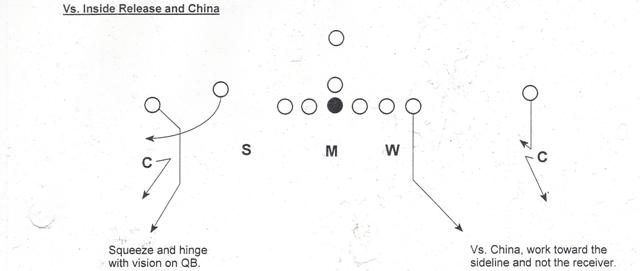
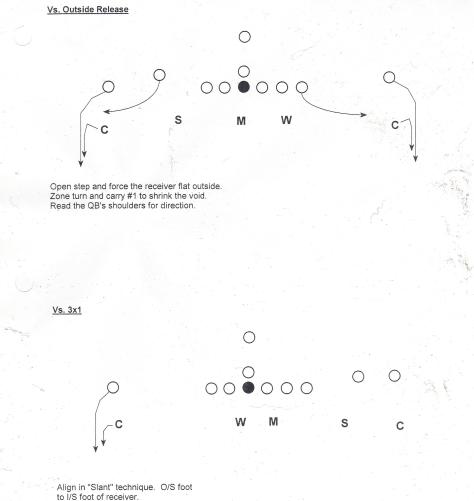
SafetiesThe safeties are deep half players in cover 2. Run plays towards the safety requires him to be an ally player, staying inside out of the ball carrier (safeties responsibility is always pass first). When run plays are away, the safety must start flat and adjust to the ball, never allowing it to cutback across his face. When there’s pass, the safety must work to his landmark between the hash and numbers. If #1 WR releases inside the safety can get to his landmark and square up with vision on QB. If #1 WR releases outside the safety must get a little more width in his landmark if the QB is looking to his side. If the #1 WR cancels himself (Run a shallow cross or blocks) then the safety can cheat to outside shoulder of #2 receiver. *Once a safety reaches his landmark he must have vision on the QB. If the QB is looking at him, he must continue to work for depth, and may have to widen. If the QB is looking away from him, the safety must backpedal weave to the innermost part of his zone.* The following are combo routes with different WR releases for Safeties. 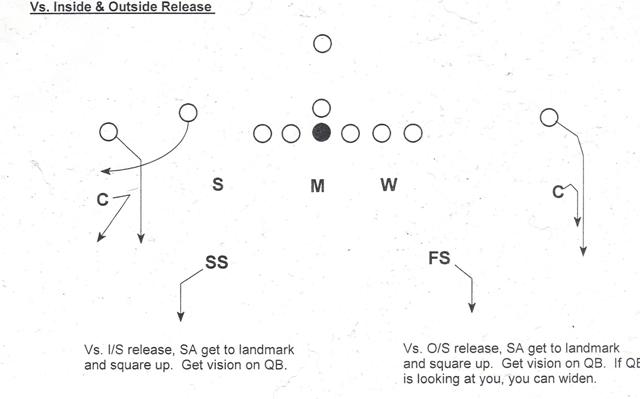
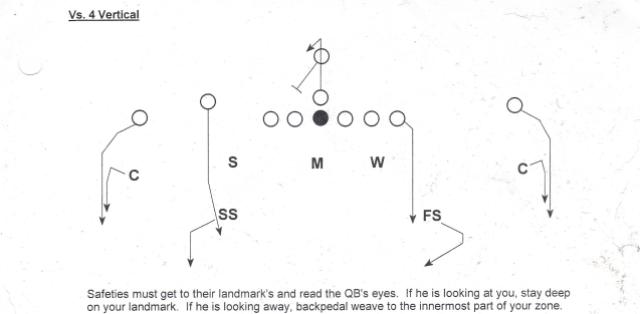
Cover 3Cover 3 is a three deep zone coverage. Once again, DB’s are required to defend a specific zone of the field. They will not chase routes, and will key the QB. This coverage also requires the free safety’s rotation to the curl-to-flat area of his side. As you go over the information below, be sure to practice the defensive back drills provided for this coverage. Cover 3 Technique Tips: Alignment Corners: A corners alignment is 8 yards deep, with his I/S foot to the O/S foot of the WR. (The corner should not cock his stance, but stay square so not to tip off the QB of the coverage) Strong Safety: The strong safety playing the deep middle should give a cover 2 disguise and work to the middle of the field as the QB goes through his cadence. Free Safety: For the free safety, he also shows a cover 2 disguise and drops to his landmark as the QB goes through his cadence (ideally both safeties should hold their disguises and move simultaneously). The free safety’s landmark is between the numbers and hash at about 12 yards from the line of scrimmage. Vs. a T.E., the free safety should drop to 5 yards deep and 3 yards wide of the T.E. Vs. a slot receiver, the free safety should be 8-10 yards deep on the outside shoulder of the receiver. Keys Corners: The corner keys the QB to the #2 receiver. If no #2, he keys the QB to #1 WR. The corner keys the 3 step drop in this coverage. Strong Safety: The deep safety keys the QB. Free Safety: The rotation safety keys the QB to the #2 receiver. Responsibilities Corners: Against running plays towards the corner he has secondary support (He plays pass first, run second). On running plays away he is the last man in pursuit.Against the pass, the corner slow pedals in order to watch for 3 step drop. His responsibility is the deep 1/3, staying deeper than the deepest. If the corner sees a 3 step drop by the QB, he settles and watches for double move by WR (It is important for a corner to know that he has a curl-to-flat player underneath so he will not have to break so quickly on short routes). A QB drop over 5 yards requires the corner to accelerate to a full speed pedal. If there is 2 receivers to the corners side he must see the release of #2. If #2 releases inside, play the #1 receiver from outside in. (Corner should not over play the post route) If #2 releases vertical, start to midpoint between the #1 and #2 receivers with vision on the QB. If the QB is looking in the direction of the Corner, he should move slightly towards #2 and force the QB to throw to #1. If the QB is looking away from the corner, he should move even more towards the #2 receiver. If #2 receiver releases outside, the corner must come off #1 and be ready to play #2 on the wheel route (WR runs a speed out, then goes vertical) *As a receiver begins to break the cushion of the corner, he should zone turn and get depth. The corner must know how many threats he has to his side. If the corner has only 1 threat, he can play man to man technique instead of zone. Though if the corner is on the single receiver side of a 3x1 formation, he must always zone turn to watch for the backside #3 receiver.* Below are examples of how corners will play cover 3 against different WR releases, personnel, and routes. 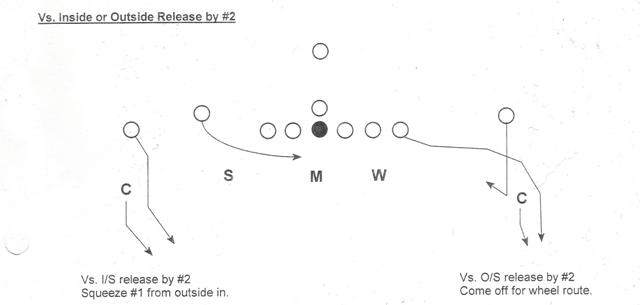
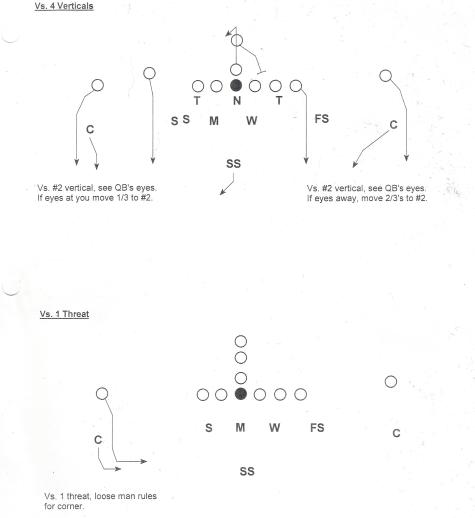
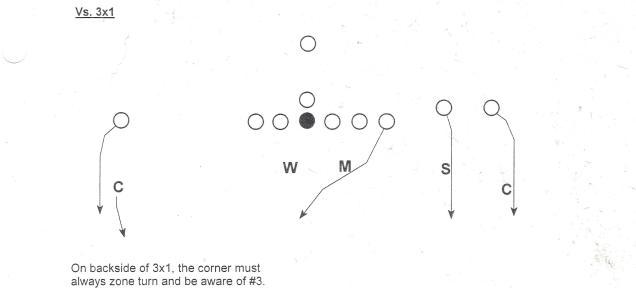
SafetiesStrong Safety: On the snap of the ball the strong safety shuffles slowly to read run or pass. Vs. run the strong safety plays the ally, staying inside out of the ball carrier, and never allowing him to cutback across his face. Against pass, the strong safety has the deep middle 1/3 responsibility. Once the strong safety sees pass he must accelerate in his backpedal and stay deeper than the deepest. The strong safety must lean on the intentions of the QB. Weaving in his backpedal, and reading the QB’s eyes and shoulders. If the QB’s front shoulder is up the safety should expect a deep throw. If his front shoulder is down, the strong safety should expect him to throw a dig or shallow crossing route. Vs. 3 step the strong safety must plant and drive to the side the QB is looking. Below is an example of a strong safety leaning toward the direction of the QB. 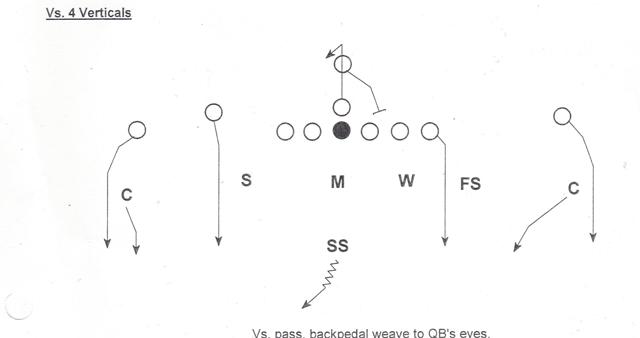
Free Safety: Vs. run plays towards the free safety becomes a box player, forcing the ball to go inside of him. When run plays are away from him, the free safety must shuffle and play the cutback, usually in the opposite B gap. Vs. the pass the free safety must open and drop to his landmark (between #’s and hash) square up and key the QB. He must break to the flat when the QB’s intentions take him there. Vs. 3 step drop the free safety should drop to the inside of the #1 WR. Vs. a #2 receiver (slot), if the receiver releases outside the free safety must jam and re-route. If he releases inside the safety must not chase the receiver but instead get to his landmark. *When the free safety drops on a T.E. he must make sure he has a good power angle approach. If the #2 receiver is in the backfield, the free safety is a box player. If the #2 is detached from the core of the offense, then the free safety is an outside the box player.* Below are some examples a free safety’s rotation Vs. different WR routes, personnel, and releases. Be sure to notice the free safety's alignment in each example. 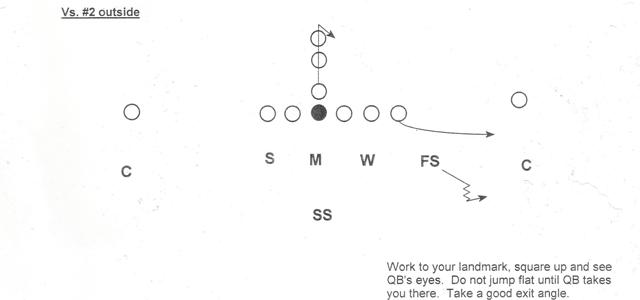
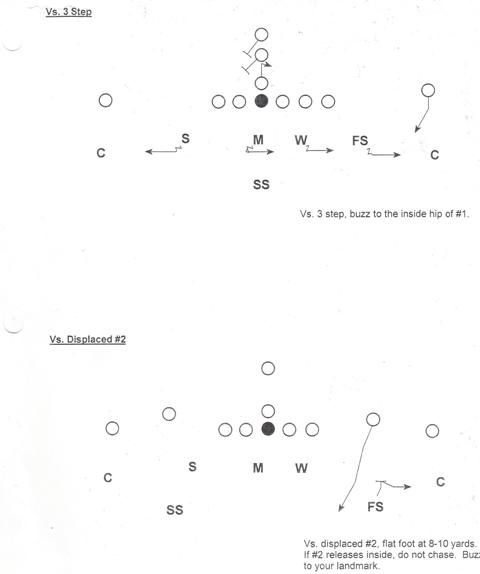
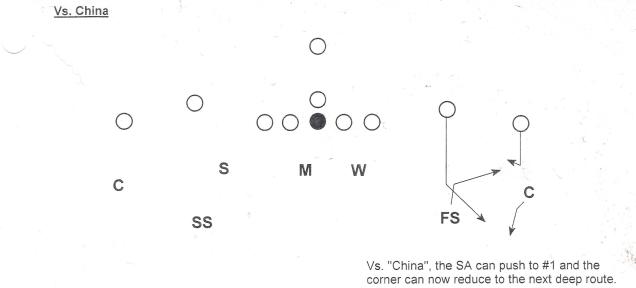
From Defensive Back, Defensive Back Drills, Strong Safety, Free Safety, Corners to Home
|
